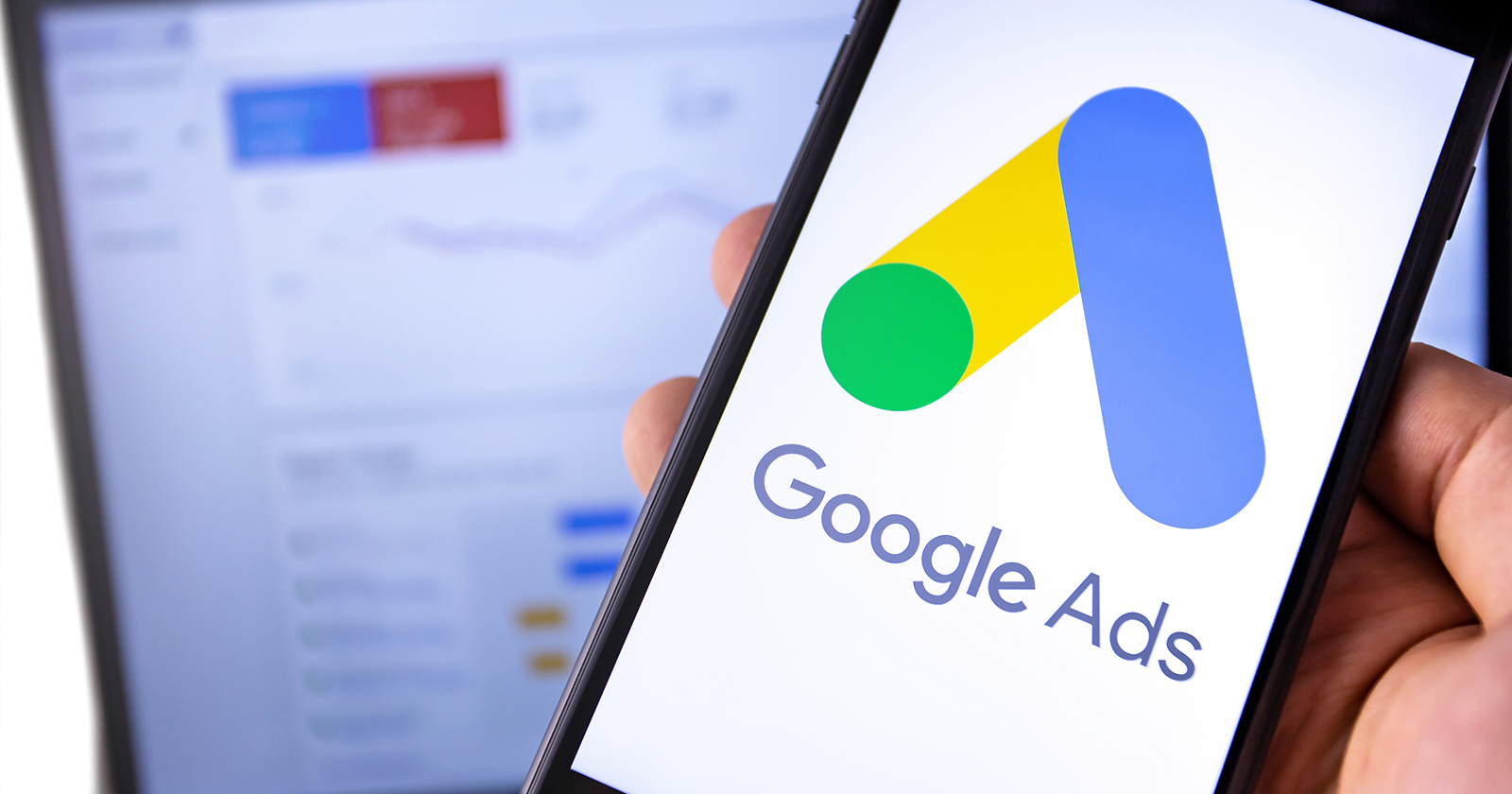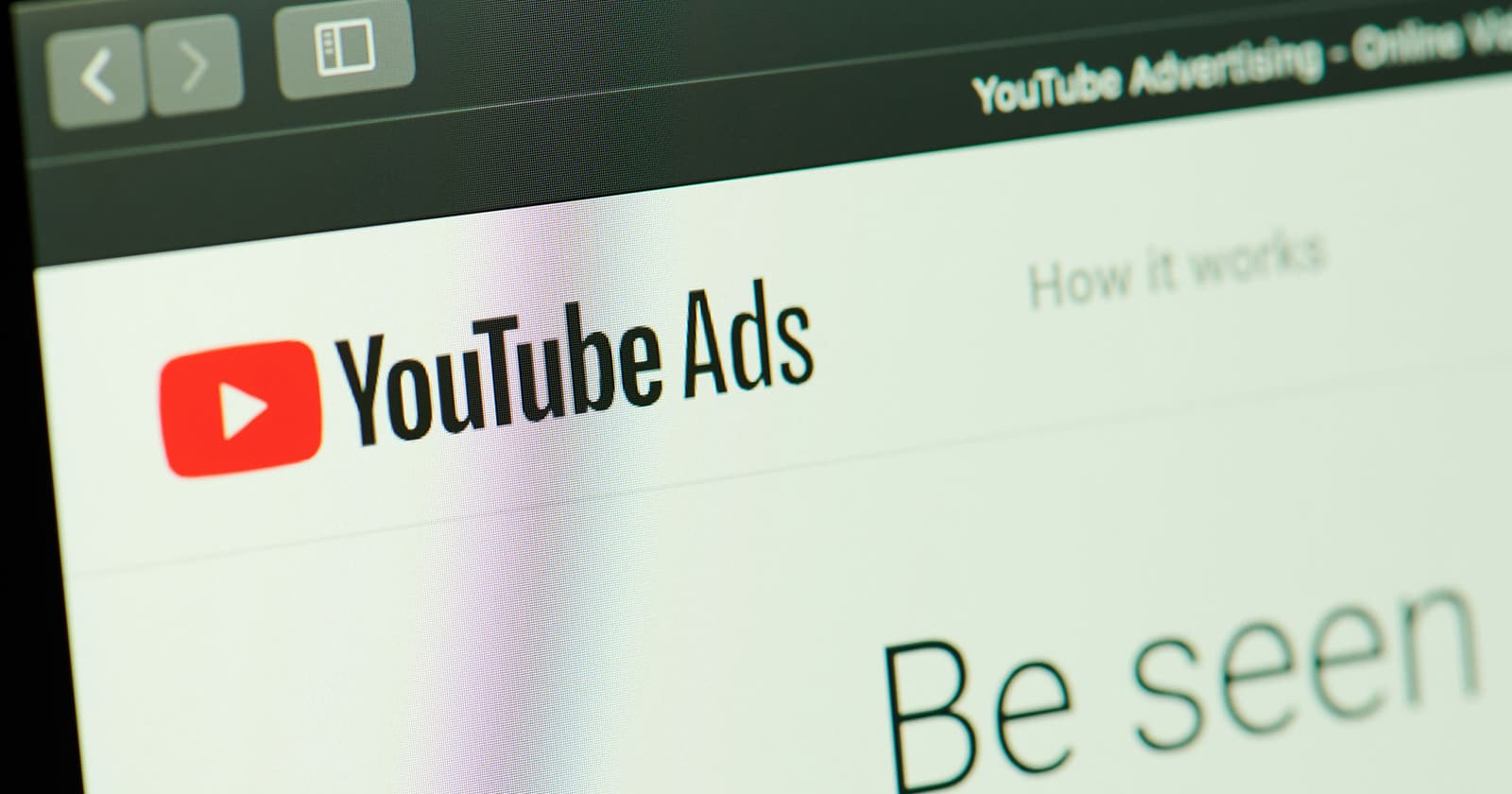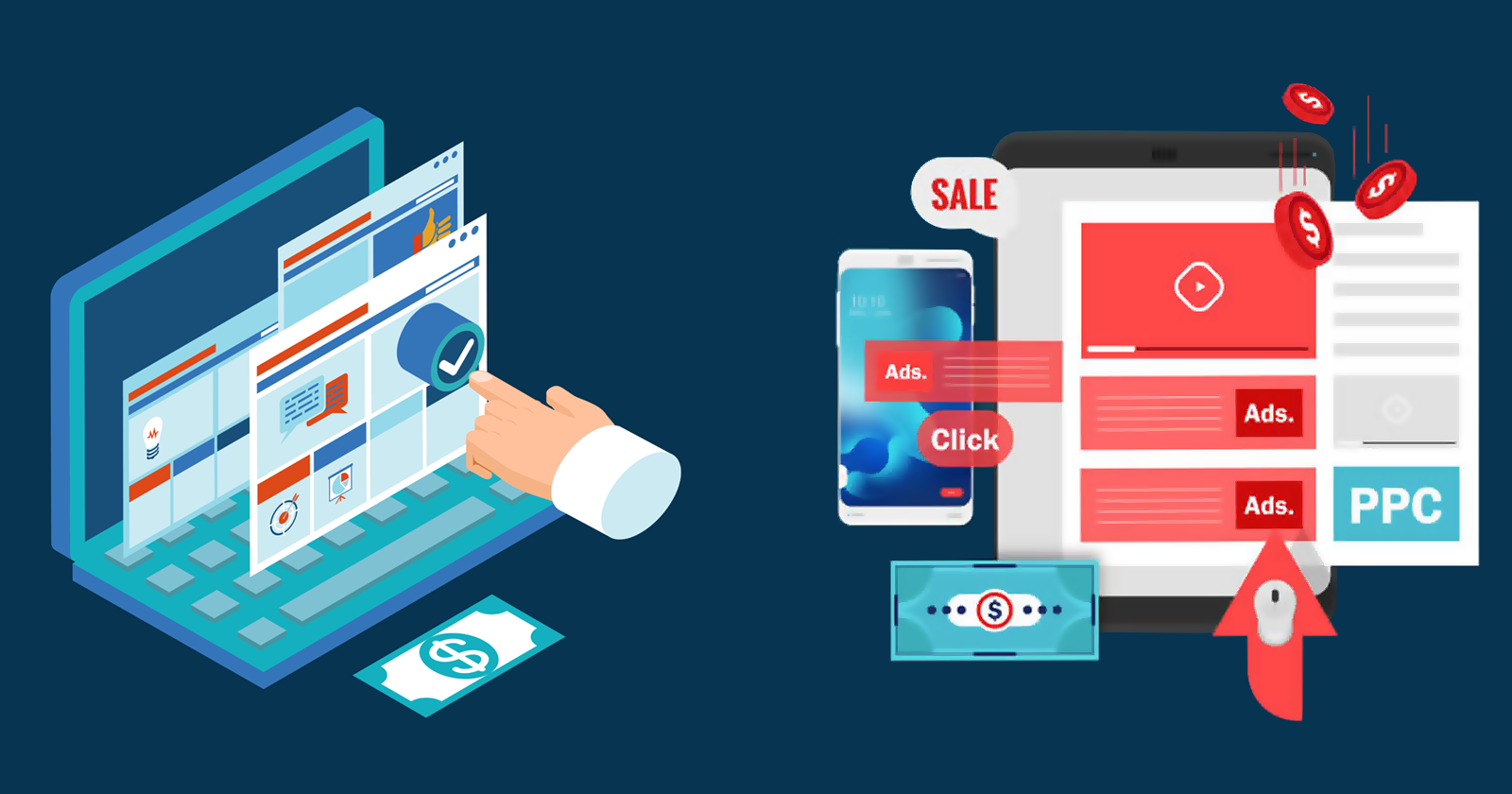Have you ever thought about how Google Ads decides the order of the ad displays on search results? It uses Ad Rank. Launching your ad is not enough; you should optimize it well to rank high on the SERPs.
Read on this post to learn what Ad Rank is, calculate it, rank factors, and use it to boost your rank.
Google Ad Rank is a value that Google Ads uses to determine your paid ad’s position on SERPs. Ad Rank does not get specified as clicks, CTR, and impressions like other Google Ads components. But it is a crucial part of ad visibility and general PPC strategy.
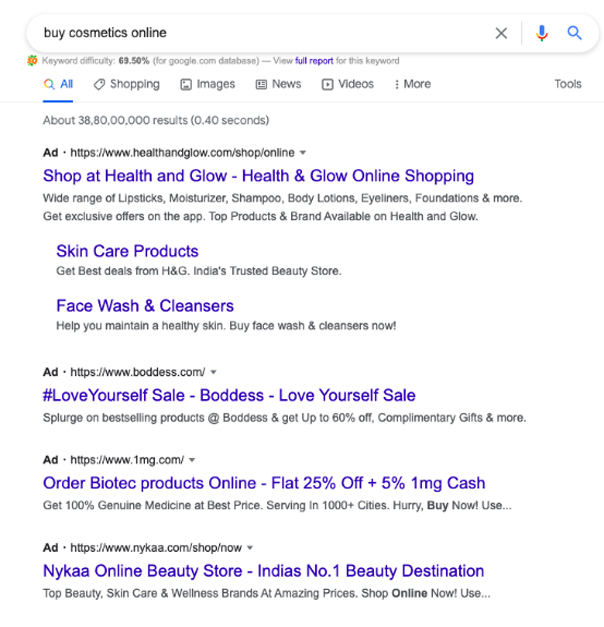
The screenshot above shows that “Health and Glow” ranks higher than “Boddess” in the ad ranks for the search term “buy cosmetics online”, which means “Health and Glow” has a higher Ad Rank than “Boddess”.
How to Calculate Google Ad Rank?
To calculate Ad Rank, use the simple formula below:
Ad Rank = CPC Bid x Quality Score
Google Ads uses an auction system and checks if the entered search query includes your bid keywords. It uses this formula to decide the ad to display and where online.
To fetch the top rank, you should have the perfect CPC bid and the highest quality score. Your ad can still rank high with a low-quality score, requiring a high CPC bid. This tends to be costly as you will have to compete with advertisers having higher Quality Scores.
The amount you invest in ads depends on your competitors and other factors. You can calculate the price by dividing your company’s Ad Rank by your Quality Score added by $0.01.
What are the Key Ranking Factors?
Ad Rank score depends on certain ranking factors that help Google determine your ad’s relevance and quality. Find the key determinants below:
Quality Score
Google calculates a Quality Score for your landing page and ad copy. The score should be relevant and helpful to the bid keywords. With the score, you can discover your ad’s position online. The image below shows how Google calculates quality scores.

Source: Wordstream
Google Ad Rank Thresholds
Your ad needs to achieve certain thresholds set by Google to display online. If your ad fails to do so, it gets ineligible to get displayed on SERPs.
Ad Extensions
Ad extensions can always help you to improve your Ad Rank. These are extra information like links to more niche content.
Ad Formats
Google determines the possibility of how other ad formats depend on your ad performance.
User Search Context
User search comprises various elements in every search. Such factors include:
- Used search terms.
- Searching time.
- Users’ location during the investigation.
- Organic search results.
- Other ads.
- The devices used by searchers.
How to Boost Your Ad Rank
To improve Google Ad Rank, you need to implement specific simple yet most effective techniques below:
Prioritize Customer Intent
Numerous advertisers focus on dynamic keyword inclusion to boost their search results and thus, tend to forget what their target customers look for. Consequently, they end up delivering the same message through different ads.
To make your advertisement stand out in a crowd, you should prioritize customer intent. Highlight the unique features of your products and services that set you apart from your competitors. Consider their fears, problems, and hopes and then frame solutions accordingly.
Create Relevant and Precise Copy
All search engine users don’t click on ads. But, those who click on ads tend to look for something specific. For instance, users tend to search for specific terms like “self-employed health insurance options” rather than broad terms like “health insurance”.
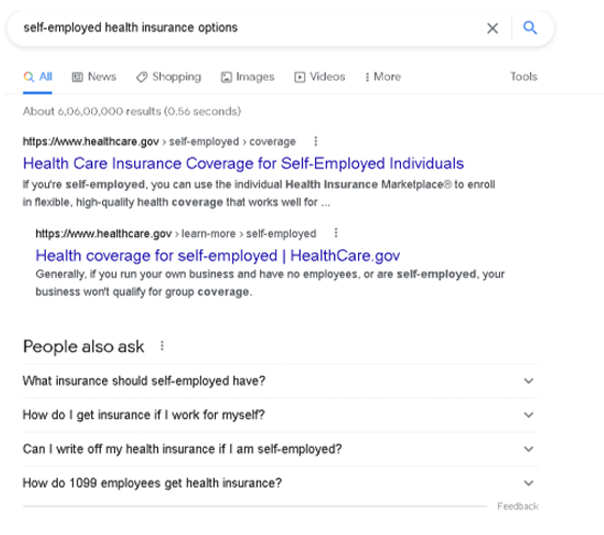
Your ad copy should stick to the main point and match the exact queries your target customers tend to search. Ensure your landing page URL is specific, so the users know they have found the required information.
Communicate in Your Customers’ Language
You should always offer customers high-quality products, services, and experiences regardless of your industry. So, you should always communicate in a language that your target audience understands.
Learn to speak in their language and use terms and phrases they understand. Work more on your brand voice, tone, and message delivery. Don’t use jargons and mention too much technologies. Put yourself in their shoes and communicate the way they think.
Add a Strong CTA
You take your customers to the right path if you add a compelling CTA to your ad. Specify what you want them to do and clearly mention what they will get if they take a positive action.
Include the price of your products or services to your advertisement. Use precise words to target your potential customers and influence them to take any action that benefits your business.
Upgrade Your Ad Copy
Ads with any sort of error harm your brand image. So, you should make most of the limited space to write an enriching ad copy. Choose the right words and phrases to upgrade your existing ad copy. Don’t use words and writing styles that seem fake. Don’t do random capitalization and make wild spelling choices.
Check if the existing copy has too many punctuations. Once you notice extra punctuations, remove them. A poorly-written ad copy leaves a negative impression on customers and they don’t trust your brand.
Add Negative Keywords to Ad Copy
Like all advertisers, you must want to rank for the most relevant keywords. You need to make sure that your ad is not ranking for the wrong keywords. Like all advertisers, you must want to rank for the most relevant keywords. Irrelevant clicks tend to frustrate your target customers which degrades your ad rank and ROI.
Reduce all the chances of irrelevant search results and clicks by adding negative keywords to your ad campaign. Negative keywords help you to block your ad from getting displayed in searches you don’t want.
Use Ad Extensions
Ad extensions add more context to your ads and direct users to specific pages and required contact information. It would be best to use only those ad extensions as unnecessary additions won’t increase CTR and degrade your Quality Score and Google Ad Rank.
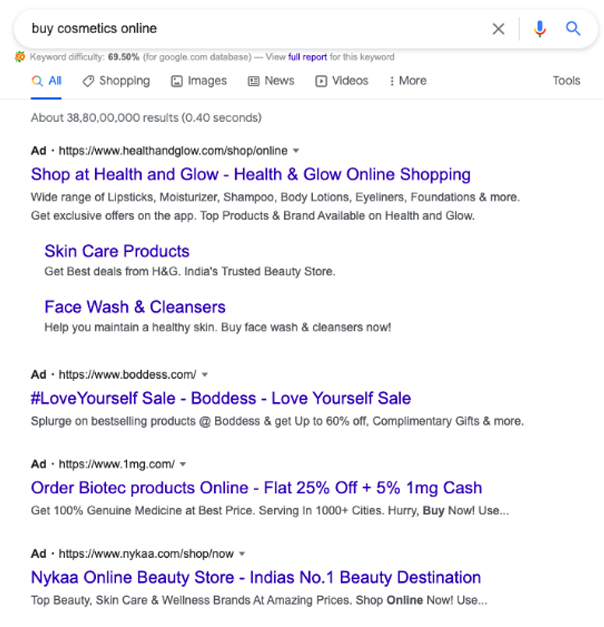
The screenshot above shows the ad extensions – “Skin Care Products” and “Face Wash & Cleansers.” Make sure ad extensions align with your CTA and advertisement campaign objectives. Google utilizes the “expected impact of extensions” to evaluate your ad’s relevance and outcome. Thus, it would be best to use ad extensions with CTA.
Increase Relevance in Your Ads
Your ad relevance to the product you promote is crucial in calculating Quality Score and, thus, your Ad Rank. All your ads should be highly relevant to the bid search terms. As performing research and understanding audience interests are essential, you should revisit audience personas, goals, and challenges. Then, you should draft your ad copy accordingly to respond to their needs directly.
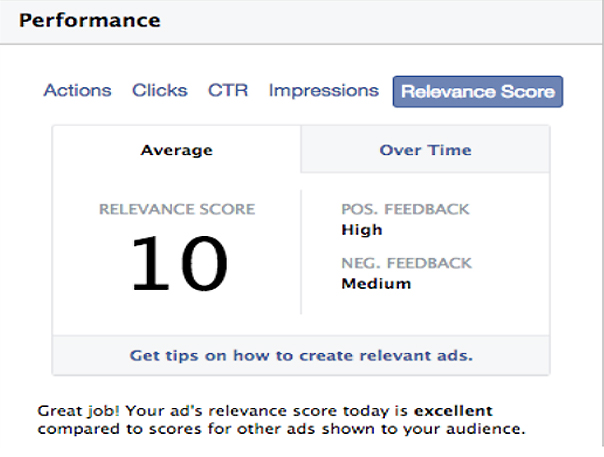
Source: Neil Patel
Use keywords in the ad title and URL to make your ad relevant to their search increase CTR and Quality Scores immediately. Always repeat the main keywords or select the right landing page that would link directly to your promoted products and services. After users get to your landing page, they will see consistency with their search queries.
Optimize Landing Page
You add value to your landing page and make it easy to navigate and modify relevant content. You add value to your landing page and make it easy to navigate and modify relevant content. The landing page content is equally vital as ad copy. If both don’t match, Google tends to consider you a fraud and view your ads ineligible for online display. Think about CX when customers access your website and page content relevance. You add value to your landing page and make it easy to navigate and modify relevant content.
You can use numerous accessible and affordable resources online to build a rich landing page and generate optimum revenues. It should take visitors directly to the page to promote your products and services. Ensure the ad copy matches the message you deliver on the landing page.
Even though you pay for ads, you should not overlook SEO basics. The perfect landing page looks similar to the Google Ad extension and completes your ad. Thus, your ad copy and design need to match Google Ad keywords. You need to add search terms to the right places on your page. Keywords need to be present in the headline, intro, and body at least once.
Make sure your landing page is easy to navigate and mobile-friendly, and increase your site speed. You can use Google PageSpeed Insights, a free tool, to check your ad page speed.
Check URL Relevancy
No user searches a query to get results that are different from what they expect. When it comes to the performance and ranking of your ads, URL relevancy matters. Your ads should suit the exact user experience that your landing page offers. Ensure you don’t mislead target visitors on any level.
Form Specific Ad Groups
Create specific ad groups to make your ads look more relevant to customers. Every ad group in the Google Ads campaign needs to focus on only one product/service, have a catchy theme, and be related to the ad group.
Post ads relevant to the used keywords to boost Quality Score and ranking. Once you create specific ad groups, build your landing pages accordingly, so each of them matches keywords and ads.
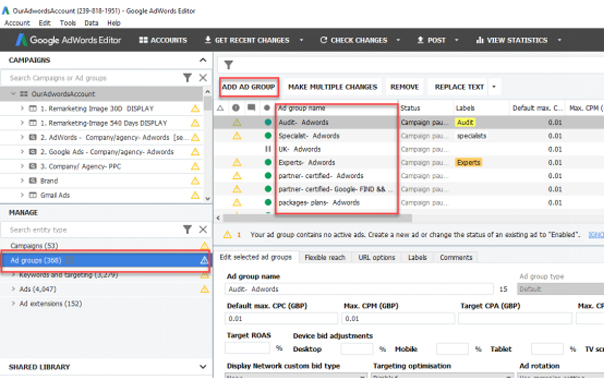
Source: One PPC
Relevant messages from ads and landing pages are proven to boost conversions by more than 200%. You can display landing pages for every ad group without building multiple different pages. Customize landing page copy for every campaign and edit small text portions to draft an exciting offer to save your time and increase conversions.
Since your ads need to be relevant, you should also make specific ad groups. You should set up a few irrelevant keywords in different groups. Every group should have a controlled theme and highly relevant keywords.
Use Single theme ad groups (STAGs) to boost CTR and Quality Score. You can also use Keyword Match Types, parameters set on keywords, to control the ad displays on SERPs.
The Broad Match Modifier only matches when you add words with a “+” sign, a Phrase Match that includes your bid terms in an uninterrupted sequence, and an Exact Match consisting of function words not displayed in the search results.
Besides evaluating the quality of your ad, Google also assesses the quality of your landing page. It would be best to always think about the user experience after they click through your ad and how easy, transparent, and relevant it is for them to navigate your landing page. It would help to optimize landing pages to offer an excellent UX throughout. If your landing page fails to deliver a fabulous experience, Google Ads will penalize you with a less Quality Score. Thus, you should do what it takes to increase your Quality Score.
Experiment With Everything
Test various offers and CTAs to check which performs better than other options. If you customize your ad copy for certain ad groups, run many ads in a specific group to find what works best for your target customers. Schedule the rotation that helps your ads switch over automatically, so you get insights into their performance.
Once you do that, you can see that some ads work better than others that you can use to customize ad copy in the future.
Add FAQ Structured Data
Experiment with new FAQ structured data that you can add to your ads. If you do so, users can directly see information in the ad that they value about your products and brand.
When you add FAQ structured data, it prevents unnecessary visits to your online store. Unnecessary website visits are used to increase bounce rates as the products would not have met your customer demand.
Remove 301 Direct Chains
301 redirect chains reflect there are many redirections between the URLs and their final destinations. The redirects can cause complications in loading or crawling the web pages of your online store. This automatically degrades the search engine rank of your website.
Ensure all your URLs link directly to the target destinations and don’t need to from HTTP to HTTPs or from https://www to HTTPS.
Boost Internal Links
When it comes to your ad rank, you need to think about internal links in your website. The interconnection of various links on your website may suddenly be a critical issue. If you don’t follow a proper structure when interlinking and just link here and there across your website, it can severely affect your ad rank.
Thus, you should build a hierarchical framework of web pages and subpages in your online store. Then, customers can easily orientate in your online store. Another positive outcome would be that Google bots can easily crawl your eCommerce websites and you can build a trusted image online.
Optimize Bid Strategy
At last, you can optimize bids to boost your ad ranks. Though, you need to invest more for more bids for clicks as that affects your acquisition costs and revenues in the long run. Thus, you should avoid increasing bids without considering the metrics. Just focus on optimizing your bid strategy.
Remember, your optimum bid determines your Ad Rank in parts. Thus, you should evaluate your bid strategy to find if it is helping you to earn the highest returns on Ad Spend (ROAS). Decide if it’s worth optimizing your maximum bid and revenue increase supersedes the cost increase.
Make sure you test numerous bidding tactics and track the performance, such as return on ad investment, cost per conversion, conversions, and conversion rates.
In a Nutshell
When your ad has a low rank, it tends not to appear in search results for targeted keywords. In that case, you can get a warning message on your Google Ads account.
The low Google ad rank can be because of the low bid’s poor relevancy. Below-average CTR and poor landing page experience. One of the easiest ways to boost your ad rank is to increase bids, increasing your costs. To do so, you need to identify quality issues and then increase your bid accordingly. When improving the overall UX, you should always form ad groups depending on the theme.
The Ad Rank scenario is consistently evolving, and thus you need to implement the most effective strategies to deliver an exceptional UX at any time. No matter the method you choose to apply, you should focus on consistent optimization, analyze results and track performance to stay ahead of your competitors and fetch the topmost rank.
As this post outlines most important things you need to know about Ad Ranks and how you can increase it, you can quickly implement most of the strategies listed here to boost your Google Ad Rank.
So what are you waiting for? Start implementing them right away! But if you apply one or more techniques, you need to consistently optimize, modify and track Google Ads campaigns for better performance.
Frequently Asked Questions
What are Google ad rank thresholds?
Your ability to participate in an ad auction is determined by Ad Rank thresholds. At the time of each auction, thresholds are dynamically established based on a variety of parameters, such as: Your advertisement’s caliber: Lower quality advertising have higher limits in order to maintain a high quality ad experience for consumers.
What is Quality Score and ad rank?
Google rates the quality and relevancy of both your keywords and PPC advertising using a system called Quality Score. Your ad rank in the ad auction process is determined by multiplying it by your maximum bid, which is used to calculate your cost per click (CPC).
How do I increase my Google Ad Rank?
Here are some of the most effective methods for boosting your ad rank without making bids.
1. Utilize search terms as keywords
2. Improve the relevance of your ads
3. Employ the Keyword Tool
4. Improve your website by working on its technical aspects
5. Include primary keywords in your website’s meta tags
What is the importance of ad Rank?
Your ad position and eligibility to appear at all are determined by your ad rank. Generally speaking, the ad with the highest Ad Rank appears in the top position, followed by the ad with the second-highest Ad Rank (provided the ads meet the necessary standards).
